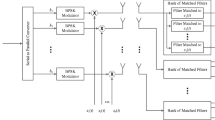Abstract
In this paper, we derive closed-form solution for the bit error rate of multi-input multi-output (MIMO) system with maximum ratio combining. We consider binary PSK modulation suffers from cochannel interference (CCI) and imperfect channel state information (CSI). We assume a propagation model wherein the desired and interfering signals undergo independent and identically distributed (i.i.d.) Rayleigh fading channels. Furthermore, the signal-to-noise ratio (SNR) gain penalty caused by the interference signals and the root mean square of the CSI were demonstrated. The numerical results presented in this paper demonstrate the system performance under very realistic propagation and detection conditions including MIMO system, CCI, imperfect CSI, generalized fading channels, and AWGN. Hence our results are expected to be of significant practical use for such scenarios.





Similar content being viewed by others
References
Winters, J. H. (1984). Optimum combining in digital mobile radio with cochannel interference. IEEE Journal on Selected Areas in Communication, 2, 528–539.
Dighe, R. A., Mallik, R. K., & Jamuar, S. S. (2003). Analysis of transmitreceive diversity in Rayleigh fading. IEEE Transactions on Communications, 51, 694–703.
Kang, M., & Alouini, M.-S. (2003). Largest eigenvalue of complex wishart matrices and performance of MIMO MRC systems. IEEE Journal on Selected Areas Communications, 21, 418–426.
Maaref, A., & Assa, S. (2005). Closed-form expression for the outage and ergodic Shannon capacity of MIMO MRC systems. IEEE Transactions on Communications, 53, 1092–1095.
McKay, M. R., Grant, A. J., & Collings, I. B. (2007). Performance analysis of MIMO-MRC in double-correlated Rayleigh environments. IEEE Transactions on Communications, 55, 497–507.
Jin, S., McKay, M. R., Gao, X., & Collings, I. B. (2007). Asymptotic ser and outage probability of MIMO MRC in correlated fading. IEEE Signal Processing Letters, 14, 9–12.
Li, M., Lin, M., Gong, Z., Yu, J., Zhang, Z., Peng, R., et al. (2007). Performance analysis of MIMO MRC systems. Electronics Letters, 43, 1–2.
Kang, M., & Alouini, M.-S. (2004). Quadratic forms in complex Gaussian matrices and performance analysis of MIMO systems with cochannel interference. IEEE Transactions on Wireless Communications, 3, 418–431.
Yang, L., & Qin, J. (2006). Outage performance of MIMO MRC systems with unequal-power co-channel interference. IEEE Communications Letters, 10, 245–247.
Tokgoz, Y., & Rao, B. D. (2006). Performance analysis of maximum ratio transmission based multi-cellular MIMO systems. IEEE Transactions Wireless Communications, 5, 83–89.
Romero-Jerez, J. M., Pena-Martin, J. P., Aguilera, G., & Goldsmith, A. J. (2006). Performance of MIMO MRC systems with co-channel interference. In: Proceedings of the IEEE international conference on communications (ICC06), pp. 1343–1349.
Rui, X. (2009). Capacity and SER analysis of MIMO MRC systems in an interference-limited environment. Wireless Personal Communications, 50, 133–142.
Ahn, K. S. (2009). Performance analysis of MIMO-MRC system in the presence of multiple interferers and noise over Rayleigh fading channels. IEEE Transactions on Wireless Communications, 8, 3727–3735.
Pena-Martin, J. P., Romero-Jerez, J. M., Aguilera, G., & Goldsmith, A. J. (2009). Performance comparison of MRC and IC under transmit diversity. IEEE Transactions on Wireless Communications, 9, 2484–2493.
Basri, A. A. (2010). Exact bit error rate of MIMO MRC systems with cochannel interference and Rayleigh fading. In: Proceedings of the IEEE 72nd vehicular technology conference (VTC’2010), pp. 1–5.
Kang, M., & Alouini, M.-S. (2004). A comparitive study on the performance of MIMO MRC awith and without cochannel interference. IEEE Transactions on Communications, 52, 1417–1425.
Romero-Jerez, J. M., Pena-Martin, J. P. (2012). ASER of rectangular MQAM in noise-limited and interference-limited MIMO MRC systems. IEEE Wireless Communications Letters, 1, 18–21.
Chen, Y., & Tellambura, C. (2005). Performance analysis of maximum ratio transmission with imperfect channel estimation. IEEE Communications Letters, 9, 322–324.
Annavajjala, R., & Milstein, L. B. (2005). Performance analysis of linear diversity-combining schemes on Rayleigh fading channels with binary signaling and Gaussian weighting errors. IEEE Transactions on Wireless Communications, 4, 2267–2278.
Li, G., & Ge, J. (2009). A simple and accurate approximation to the SEP of MIMO-MRC systems with channel estimation error in the presence of cochannel interferences. In Proceedings of the 5th international conference on wireless communications, networking and mobile computing (WiCom’09), pp. 1–4.
Tang, D., Lv, M., & Huang, G. (2009). Multiuser performance analysis of MIMO-MRC systems under co-channel interference and channel estimation error. In Proceedings of the 2nd IEEE international conference on computer science and information technology (ICCSIT’ 2009), pp. 454–457.
Ahn, K. S., & Heath, R. W. (2009). Performance analysis of maximum ratio combining with imperfect channel estimation in the presence of cochannel interferences. IEEE Transactions on Wireless Communications, 8, 1080–1085.
Rui, X., Jin, R., & Geng, J. (2007). Performance analysis of MIMO MRC systems in the presence of self-interference and co-channel interferences. IEEE Signal Processing Letters, 14, 801–803.
Smadi, M. A., Prabhu, V. K., & Al-Jazzar, S. O. (2009). Analytical study on the effect of cochannel interference on partially coherent diversity systems. IEEE Transactions on Communications, 57, 117–124.
Ahn, K. S. (2008). Performance analysis of MIMO-MRC system with channel estimation error in the presence of cochannel interference. IEEE Signal Processing Letters, 15, 445–448.
James, A. T. (1964). Distribution of matrix variates and latent roots derived form normal samples. The Annals Mathematical Statistics, 35, 475–501.
Gradeshteyn, I. S., & Ryzhik, I. M. (1994). Table of integrals, series, and products. New York: Academic.
Acknowledgments
Authors would like to thank the Deanship of Scientific Research at King Faisal University (KFU), Al-Hasa, Saudi Arabia for supporting this research as part of project no. (140072).
Author information
Authors and Affiliations
Corresponding author
Rights and permissions
About this article
Cite this article
Smadi, M.A., Al-Haija, Q.A. & Itradat, A.H. Exact Error Rate Analysis of MIMO-MRC System under Cochannel Interference and Imperfect Channel State Information. Wireless Pers Commun 79, 847–859 (2014). https://doi.org/10.1007/s11277-014-1890-0
Published:
Issue Date:
DOI: https://doi.org/10.1007/s11277-014-1890-0




